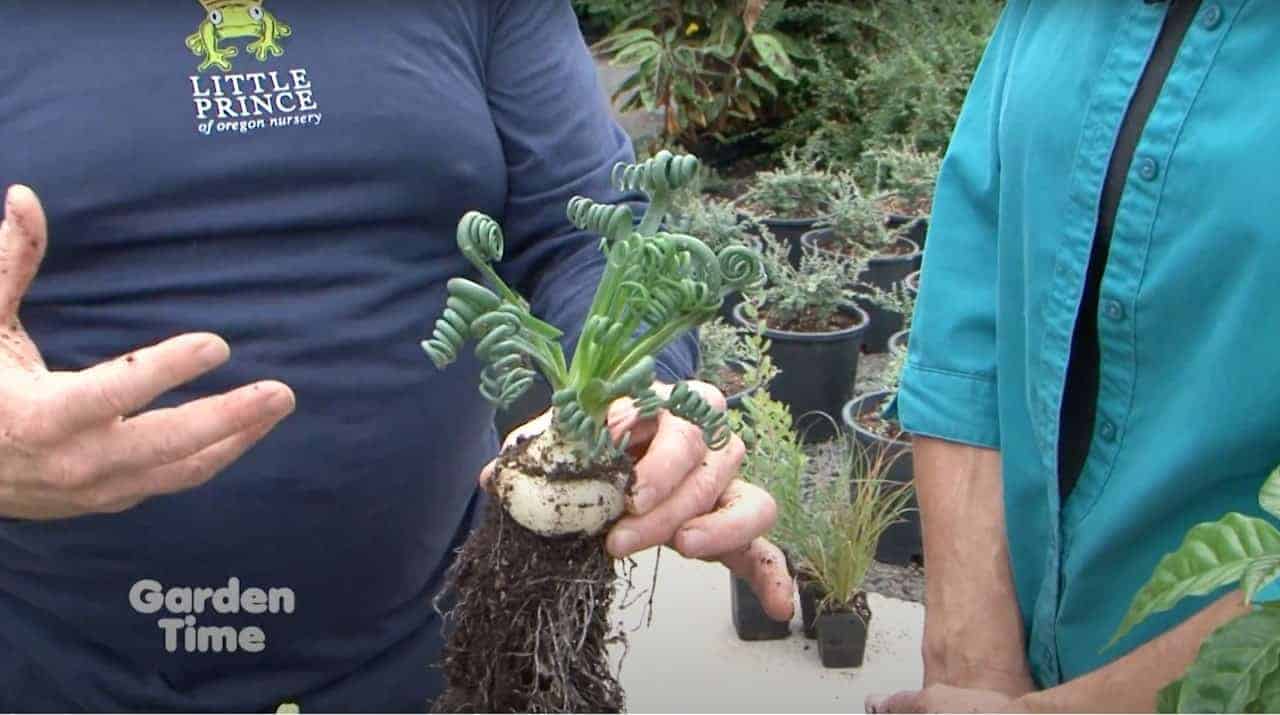The Trachyandra Plant is a unique-looking succulent native to South Africa and Madagascar. Though there are a handful of species within the Trachyandra genus, the common name most frequently refers to the species Trachyandra tortilis.
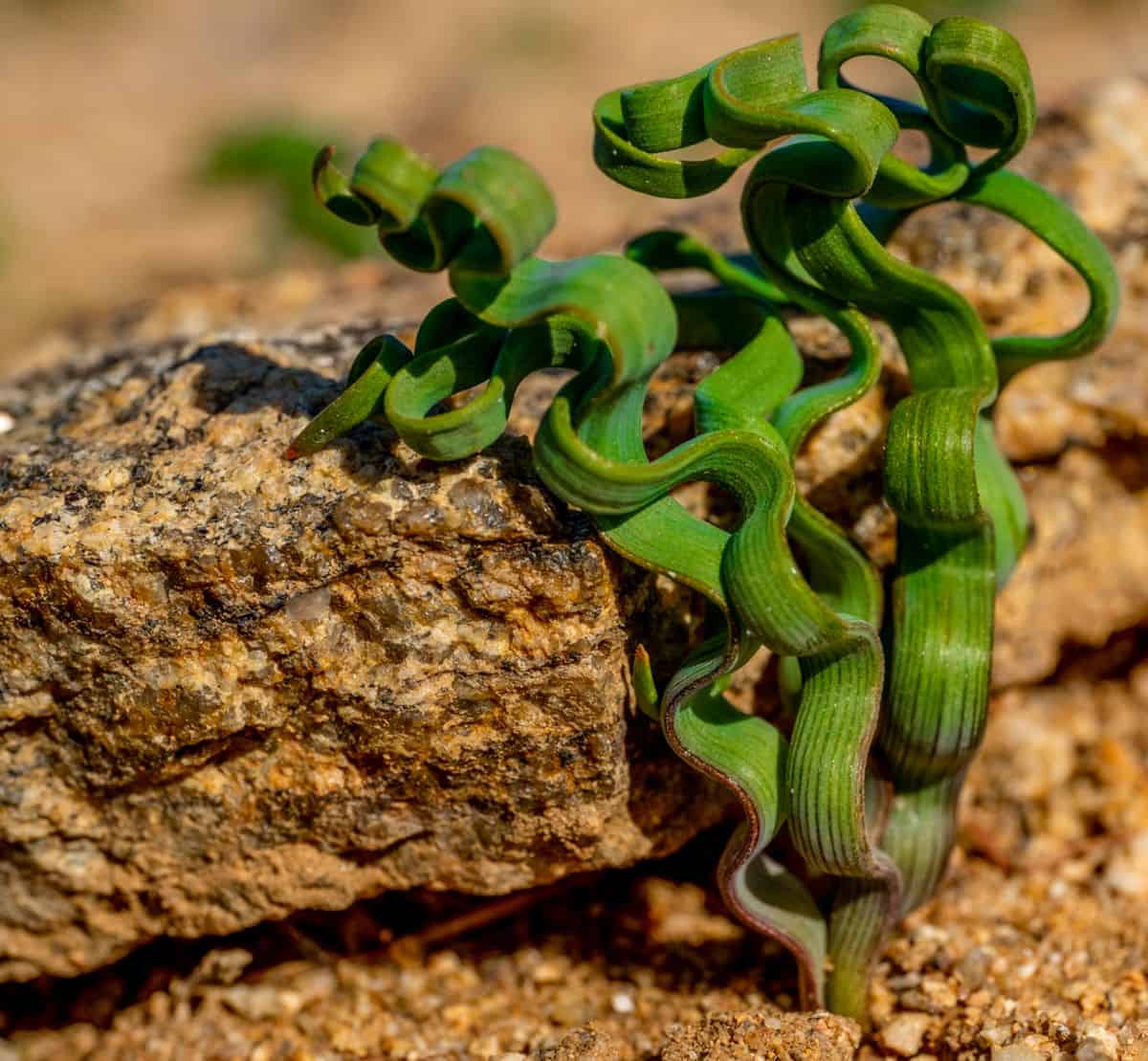
T. tortilis is a relatively rare succulent, but it’s highly sought after by collectors. When you do find this plant, it may quite expensive as they are difficult to find in cultivation and their price will reflect that.
However, most succulent lovers would agree that the Trachyandra Plant is worth the trouble. Its distinctive curly leaves add a touch of whimsy to any succulent collection or garden.
Jump to:
Trachyandra Plant Appearance
| Name: | Trachyandra tortilis |
| Soil: | Well-drained sandy or rockysoil |
| Blooming: | Late winter or early spring |
| Light: | Bright, indirect light |
| Water: | Fully dry out before watering |
| Propagation: | Leafcuttings and seeds. |
The Trachyandra Plant stands out from other members of its genus. While other species of Trachyandra have straight, erect leaves, this species has curly, ribbon-like leaves. The leaves fold and coil in a manner unique to each plant.
There are generally between three and six leaves present on a mature specimen. The leaves generally reach about four inches in length and an inch in width, while the entire plant tends to stay around 10 inches in total height.
When in bloom, T. tortilis produces a branched spike from the center of the plant that is covered in pale yellow flowers. This species generally blooms in late winter or early spring.
The delicate, star-shaped flowers typically last just a day, so if you’re expecting your plant to bloom, keep a close eye on it so you don’t miss the flowers!
Caring for Trachyandra Plant
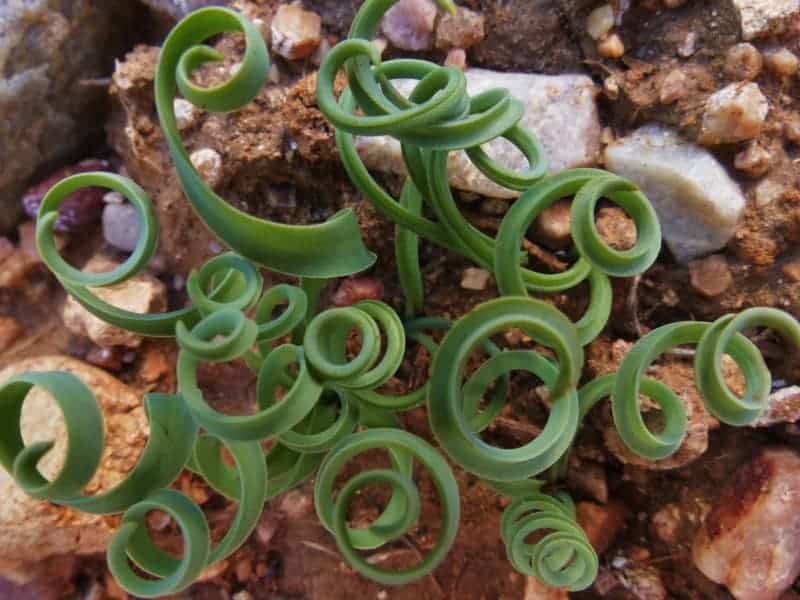
Buy it from:
Not only is the Trachyandra Plant difficult to find, but it can also be more difficult to care for than your average succulent. These are incredibly delicate plants that require very specific care.
Combined with the potentially high price of the plant, to begin with, most gardeners would recommend this plant for experience succulent caretakers. This is not to say that a beginner would not be able to keep a Trachyandra Plant alive, but it may be more difficult if you aren’t familiar with the general needs of succulents.
However, if you can manage to give your Trachyandra Plant the right type of care, you may just be blessed with a day of beautiful blooms sometime in late winter or early spring.
Light
The Trachyandra Plant will grow best in bright, indirect light. Ideally, they should receive at least six hours of light per day. However, it’s important to note that these delicate plants are incredibly sensitive to direct sunlight.
If your T. tortilis is exposed to direct sunlight, it may burn. Unless the burn is extreme, it will likely not result in the death of the plant. However, the black or brown spots on a sunburned succulent’s leaves are unsightly and cannot be repaired.
If you are unlucky enough to have a sunburned Trachyandra Plant, you’ll need to either trim away the burned leaves or simply wait until it’s replaced by new growth.
Placing your succulent in a bright, sunny room just out of reach of direct sunlight is ideal, but this is not a plant suitable for low-light environments. Without enough light, Trachyandra Plants are at risk of etiolating, or stretching out.
No products found.
If you believe that your indoor space won’t provide your succulent with an adequate amount of light each day, you might consider investing in a grow light. Grow lights are an easy and typically inexpensive way to increase your plants’ daily amount of light.
Full-spectrum grow lights come in a variety of shapes and sizes to suit your indoor space. Whether you need a single light for your Trachyandra Plant, or a light to cover an entire shelf of plants, you should be able to find a grow light in your budget.
Like sunburn, etiolation cannot be repaired, so it’s best to address your low light problem before it begins to affect your plant’s shape.
Water
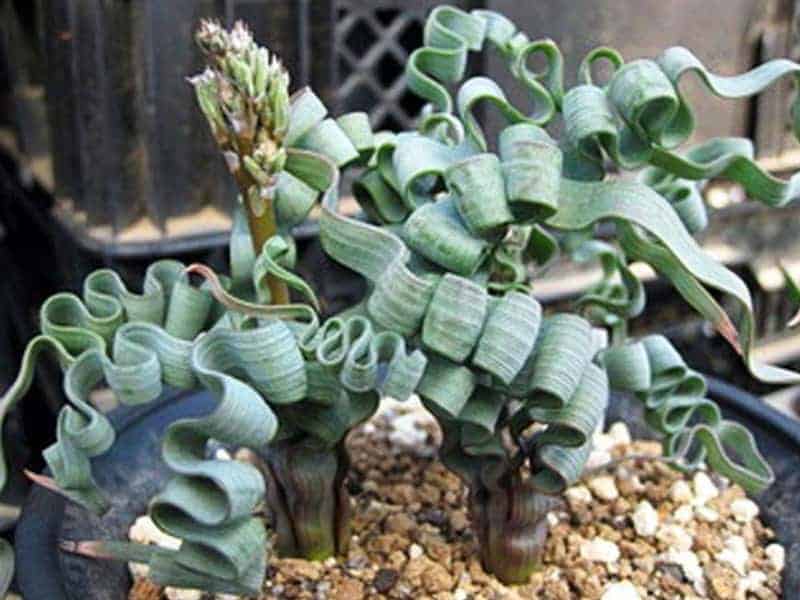
Like most succulents, the Trachyandra Plant does best with the soak and dry method of watering. This method involves soaking the soil to the point that the excess water drains from the bottom of the pot. Then the soil is allowed to fully dry out before watering again.
Though all succulents will suffer when overwatered, Trachyandra tortilis is particularly sensitive to overwatering so you must be careful about its watering schedule. Additionally, this plant’s water needs to change with the seasons, so you must be willing to adjust your watering schedule accordingly.
Remember, overwatering is not about the amount of water you give your plant, but the frequency. The soil can only hold so much water, so whether you give it just enough to soak the soil in the pot, or that amount and more, your succulent will be fine so long as you allow the soil to dry out before giving it more water.
To ensure that you’re only watering your succulents when the soil is dry, it’s recommended to test the moisture level of the soil prior to watering. This can be easily accomplished using high-tech tools such as a soil moisture meter or your finger.
To test the soil moisture level, insert the tool of your choice a few inches into the soil near your Trachyandra Plant’s roots. If your moisture meter or finger sense moisture, you’ll need to wait at least a few days before testing again.
If the soil is dry, you can proceed with watering your plant without worrying about accidentally overwatering. Testing the soil like this is recommended over a set watering schedule because it accounts for changes in weather and humidity.
In hot, dry weather, your soil is likely to dry out much faster than it would in cool, humid weather so you’ll probably need to water more frequently. Water won’t evaporate as quickly in cool or humid weather or climates, so you may be able to go longer between watering. The type of container you plant your succulent in may also affect how often you water.
In most cases, you’ll likely find yourself watering your Trachyandra Plant about every two to three weeks.
However, you will also need to adjust your watering schedule to accommodate your Trachyandra Plant’s summer dormancy. Like other species of succulent native to southern Africa, these plants go dormant in the summer, rather than the winter.
This means that you’ll need to significantly reduce watering during the summer months, increasing frequency in the fall when the Trachyandra Plant begins actively growing once more.
Temperature
Like many other species of succulent, the Trachyandra Plant is not frost tolerant. This delicate plant generally won’t do well in temperatures below about 40 degrees Fahrenheit. If you live in a climate where you can grow this plant outdoors, you’ll need to plan on bringing it inside any time you’re expecting frigid temperatures.
If you’re growing your Trachyandra Plant indoors, you likely won’t need to worry about exposing your succulent to freezing temperatures. However, you should still place it in an area free from sudden changes in temperature.
Since Trachyandra Plants are native to southern Africa, they can tolerate hot weather better than some species. This is partially due to their need for indirect sunlight. Extreme heat is less of a problem when the plant isn’t getting direct sunlight.
However, in warmer weather, you may need to plan on watering your Trachyandra Plant more frequently. Depending on the climate where you live, your summers may not be extremely hot, so you won’t need to water your dormant succulent very often. If you live in a hotter area, such as the southwestern United States, you might need to keep your succulent a bit more hydrated.
Soil
The type of soil needed by Trachyandra Plants isn’t too different from the soil required by other species of succulents. In order to encourage proper drainage and prevent root rot, soil that allows excess moisture to quickly drain away is recommended.
If you’re not a DIY-type gardener, you can opt for a commercial soil mix rather than making your own. Commercial soils formulated for succulents and cacti are ideal.
These types of soil mixes typically contain large particles such as coarse sand, gravel, and perlite. Large particles encourage better drainage and airflow around the roots, which will help prevent the plant from being overwatered.
If you need more drainage than your commercial soil mix can provide, you can always add more of these ingredients to further improve drainage. The grittier your soil mixture is, the more quickly it will allow water to drain away.
No matter what type of soil you use, it’s important to avoid lining the bottom of your container with rocks. Though this is often recommended as a method of improving drainage, it can actually put your Trachyandra Plant at risk of being exposed to excess moisture.
Rather than encouraging better drainage, the rocks elevate the soil’s water table. This places the water closer to the surface and closer to your plant’s roots rather than allowing it to drain away.
Trachyandra tortilis is not a plant that needs frequent fertilizing. However, if you believe that your succulent has absorbed the nutrients from its current soil, you can add fertilizer if you wish. Just be sure to do so during the plant’s active growing season in the winter rather than during its summer dormancy.
Container
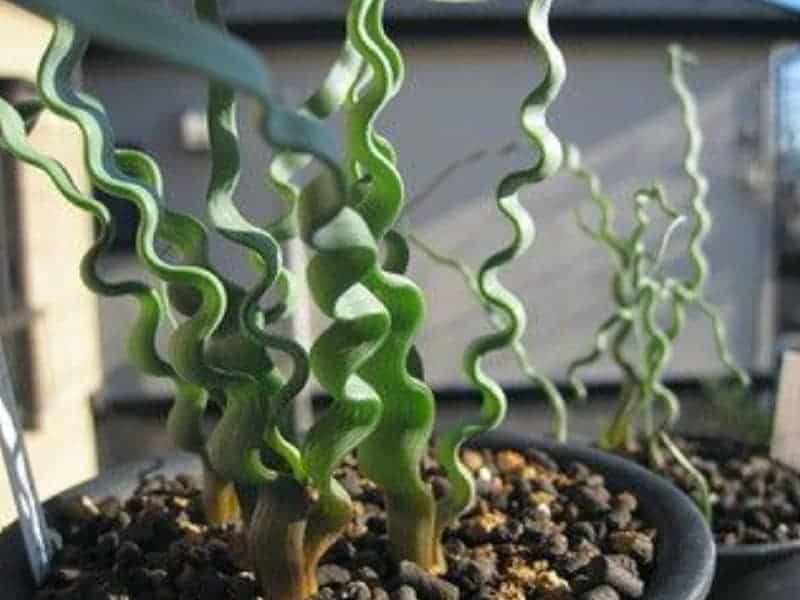
The type of container you use for your Trachyandra Plant will depend partly on your preferences, but there are a few aspects to consider. The most important aspect of choosing a pot is drainage.
Trachyandra Plants are incredibly delicate and sensitive to overwatering. It is not recommended to attempt growing these succulents in a container lacking drainage holes. You would need to be incredibly precise in watering to succeed.
Instead, choose a container of any material as long as it has holes in the bottom to allow excess moisture to escape.
The material your pot is made of will depend on your preferences. Terra cotta pots are the most common choice. Though simple in appearance, terra cotta can absorb some water from the soil, which can aid in preventing overwatering.
However, that absorption will also need to be considered when watering your succulents in hot water as the soil will dry more quickly.
Plastic or glazed ceramic pots cannot absorb water, so you’ll need to consider that factor in determining how often to water your Trachyandra Plant.
Propagating Trachyandra Plant
Trachyandra Plants tend to be difficult to find and expensive, so it only makes sense to propagate this plant yourself. If you’re a skilled enough gardener to keep this succulent alive and thriving, you’re likely skilled enough to successfully propagate it as well.
There are two recommended methods of Trachyandra Plant propagation: leaf cuttings and seeds. As with most succulents, one method is preferred above the other, but if you’re feeling adventurous don’t be afraid to try both.
Cuttings
The easiest method to propagate this plant is by using leaf cuttings. However, it’s important to choose only healthy leaves for your cuttings to increase your chances of success. The leaves you choose should be plump and healthy, rather than dehydrated or discolored. Avoid using damaged leaves as well.
To remove your chosen leaves from your Trachyandra Plant, carefully cut off a leaf near its base using sharp, sterile scissors or shears. You can use a knife with many species of succulents, but the unique shape of these particular leaves can make using a knife difficult without damaging the plant.
Once you’ve collected your cuttings, you’ll need to leave them in the open air for a few days before planting. This gives your cuttings a chance to callous, which will help prevent any potential infection by bacteria or fungus once you introduce them to the soil.
After the cuttings’ wounds have calloused, you’re ready to plant. Before you stick your cuttings in the well-draining soil you have prepared, you may want to dip them into a rooting aid such as rooting hormone powder.
This step isn’t necessary, but many gardeners find that it may help stimulate root growth more quickly. There are plenty of successful gardeners who do just fine without it, so it’s up to you whether you take this additional step.
Finally, place the cuttings in the soil with the cut side of the leaf facing downward. Ideally, you’ll be using the same type of soil you use for your mature Trachyandra Plants to help promote proper drainage and prevent your cuttings from rotting.
Once the cuttings have been placed in the soil, you’ll want to water them sparingly for the first few weeks. Without roots, the cuttings can’t absorb water well and if you overwater them at this stage, you may accidentally cause them to rot.
After a few weeks, you should begin seeing tiny roots developing at the base of the leaves. At this point, you can begin treating your cuttings more like a mature Trachyandra Plant. If your propagation has been successful, you’ll soon see your cuttings sprouting new leaves.
Seeds
Another potential method of propagation that you may use with your Trachyandra Plant is growing new plants from seeds. This is generally not the preferred propagation method, simply because growing a plant from seed is far more time-consuming than growing one from cuttings.
Trachyandra tortilis is not a quick-growing plant, so you may be waiting quite a long time for a mature plant if you go this route. Additionally, successful seed germination is not guaranteed, so your chances of success are not as high as with cuttings.
However, if you’re determined to give this method a try, you’ll need to first get your hands on Trachyandra Plant seeds. If you already have Trachyandra Plants, you can collect seeds yourself after blooming and pollination.
If you’re unable or unwilling to collect your own seeds, you may also be able to purchase them from a reputable seed vendor. There are many seed vendors online that specialize in rare or difficult-to-find plants, so it shouldn’t be impossible to find one that sells Trachyandra Plant seeds.
Once you have the seeds in your possession, you’re ready to plant. You’ll need to prepare a tray of the same well-draining succulent or cactus soil you’d use with a mature Trachyandra Plant. A seed tray works well as they often come with covers to help retain moisture.
Sprinkle the seeds across the surface of the soil. You can then sprinkle a bit of soil over the top if you wish, but don’t bury the seeds too deeply.
You’ll need to keep the soil moist, but not overly wet. Soaking wet soil can cause the seeds to rot, so slightly damp is preferable.
You can cover the seeds with a plastic cover or use a sheet of plastic wrap or glass to help retain moisture, but this step may not be necessary for humid climates.
It can take several weeks or even months for the seeds to germinate, so it’s important to be patient during this time. Eventually, you should see tiny seedlings sprout from the surface.
At that point, you can begin to allow the soil to dry out more and start treating the seedlings more like a mature Trachyandra Plant.


